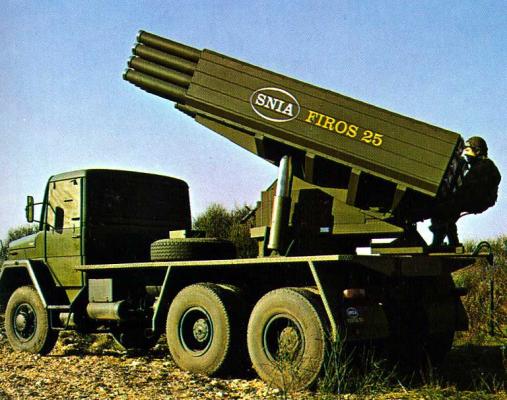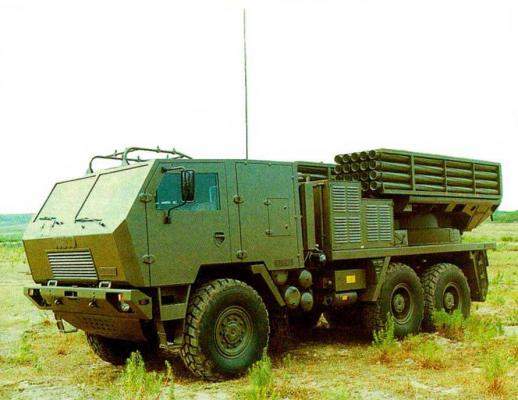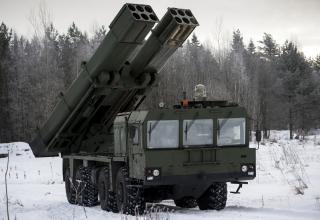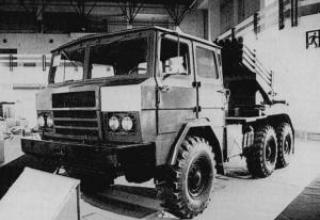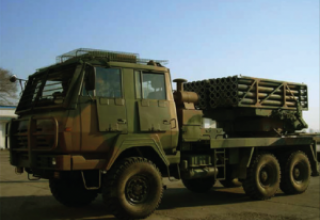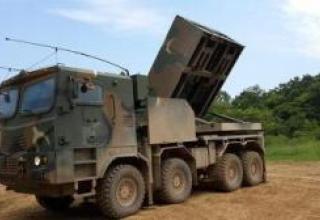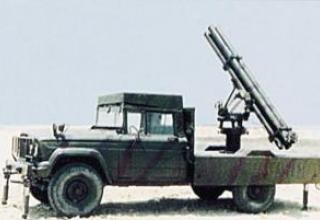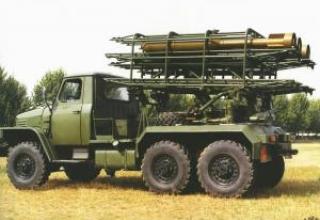The FIROS (Field Rocket System) field rocket system was developed by the Italian company PD Difesa e Spazio SpA (now Simmel Difesa SpA). The development of the first version of this system, designated FIROS-25, began in 1976 and the system was tested in April 1978, which was completed in 1981.
FIROS-25 was intended for export and supplied to the Armed Forces of the United Arab Emirates (UAE) as well as presumably Syria and Libya.
Later on, an improved version of the system was developed, with a longer range and a range of combat equipment. Under the name FIROS-30 this system was adopted by the Italian Army in 1987. As of 2002, 146 combat vehicles of FIROS 25/30 modifications have been produced.
In 1995 there were cases of fire and detonation of FIROS 25 rockets, stored in the UAE Armed Forces. According to the representatives of the developer the mentioned incidents were connected with violation of temperature regime during storage in hot climate conditions. At the end of 1996 FIROS 25 systems were taken out of service in the UAE and as of the middle of 2002 were in reserve.
FIROS-25/30 field jet systems have not had much commercial success. The Italian Army did not resume purchasing FIROS-30 due to the transition to a single 227 mm MLRS system for NATO countries. On the international market FIROS-25/30 is experiencing serious competition from the widespread Russian M-21 Field Rocket System (MLRS Grad) and its copies, as well as from variants based on it produced in different countries. Taking into account the modernization of the BM-21 and its missiles FIROS-25/30 loses to the Russian analogue in a wide range of operational and combat qualities.
Composition:
FIROS-25/30 includes:
- combat vehicle (BM) (see diagram),
- 122 mm unguided rockets (NURS) (see description),
- fire control system
- transport and charging machine (TZM).
Both FIROS combat vehicles are designed according to the classic layout with artillery on the rear of the vehicle chassis. The artillery part of the FIROS-25/30 (see photo) consists of a pivoting frame with two packs of tubular rails (20 pcs. in each package). Guidance mechanisms and a missile launch system are also mounted on the pivoting frame. Guidance mechanisms make it possible to guide the guide package in a vertical plane in the range of angles from 0° to +60°. Guidance angle in the horizontal plane is ±105°. The artillery part can be mounted on doruotan chassis of almost any three-axle vehicles with high cross-country ability of 10 tons. The engine and control cabin of the PU are located in the front part of the unit and can be equipped with light armour protection at the customer's request. The combat vehicle, which is in service with the Italian army, is made on the chassis of the truck "Iveco" (6x6) and has a fairly high speed and good cross-country ability. Weight of the BM is 17.3 tons.
For firing control various SWS can be used: from the simplest, based on the application of conventional sighting devices, to SWS with partial automation of data preparation for firing the control vehicle, which is part of the battery of launchers. A more advanced on-board fire control system has also been developed, including an electronic computer unit, a navigation equipment complex and an automated guidance system. This option allows the crew to perform the calculation of data for firing, pointing of the guide package, selection of salvo parameters and installation of NURS fuses from the cockpit of the combat vehicle. Calculation of the combat vehicle - 3 persons, time to transfer from marching to combat position - 5 min. When using an automated LRS, calculation - 2 persons, time to transfer to combat position - 1 minute. Salvo time is 16 seconds (see image).
For the FIROS system SNIA BPD developed 122-mm unguided rockets. The NURS is launched from a tubular guide rail and contains a head end, fuse, engine with nozzle block, stabilizer with blades, contact cover and drive pin. To give the projectile rotational motion during its movement on the guide, it is equipped with a screwed U-slot, on which the projectile's drive pin slides. In flight, the projectile is stabilized by the expanding tail fins, each of its blades is placed at an angle of about 2° relative to the longitudinal axis of the projectile. The head end of the NURS is inseparable.
The projectiles of the FIROS family have the same caliber but are equipped with different jet engines and head units, so they have different maximum range. FIROS-25 fires 122 mm projectiles with a range of up to 25 km. The NURS FIROS-25 engine is equipped with a 22.2 kg ballistic fuel charge. FIROS-30 can be fired from FIROS-30 with a 24 kg engine equipped with a mixture of fuel and extended operating time. NURS FIROS-30 has a maximum range of 34 km. Flight speed - 475m/s. The minimum firing range is 8 km. Firing at minimum and intermediate ranges is provided by installing a package of rails at low angles of elevation, which adversely affects the heap of firing.
The FIROS NURSE is equipped with a range of head units:
- Shrapnel-flash (charge weight BB - 3.3 kg),
- smokin',
- incendiary (equipped with a white phosphorus charge),
- the cassette,
- training workshop.
The main options for equipping NURS are shrapnel-and-phase and cassette HF. The cassette warhead is equipped with 77 cumulative shrapnel warheads, 6 anti-tank mines or 22 antipersonnel mines and has a non-contact fuse, the time of activation of which is set by fire control equipment. If necessary, both versions of FIROS can fire Soviet M-21 rocket launchers.
The launcher is recharged by replacing the guide packs using the crane of the transport and charging machine. Recharging time is 5-7 minutes. Each TZM is equipped to transport four charged modules. There is also a variant of manual recharging of the launcher.
The battery of the FIROS-30 Field Rocket System consists of: six combat vehicles, from six to twelve TZM, command and staff vehicle.
Characteristics:
| FIROS-25 | FIROS-30 | |
| Caliber, mm | 122 | 122 |
| The length of the NURS, mm: - with shrapnel-fugasal HF - cassette-based |
2680 3344 |
2820 3320 |
| Weight of NURS, kg: - with shrapnel-flash HF - cassette-based |
58.08 71.35 |
65.03 71.05 |
| Maximum NURS flight range, km: - with shrapnel-fueled hF - cassette-based |
25 22 |
34 30 |
| Package dimensions (20 rails), mm: - length - width - altitude |
3700 820 690 |
3700 820 690 |
| Package weight (20 rails), kg: - with shrapnel-flash HF - cassette-based |
1566 1806 |
1710 1810 |
Sources:
- В.Н. Шунков "Ракетное оружие" Минск 2001г. 528с.
- Электронное издание книги С.В. Гурова "Реактивные системы залпового огня. Обзор".
